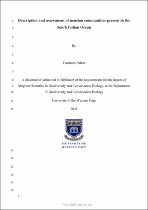| dc.contributor.advisor | Gibbons, Mark | |
| dc.contributor.author | Parker, Yasmeen | |
| dc.date.accessioned | 2022-07-28T07:29:20Z | |
| dc.date.issued | 2022 | |
| dc.identifier.uri | http://hdl.handle.net/11394/9176 | |
| dc.description | >Magister Scientiae - MSc | en_US |
| dc.description.abstract | Animal communities living at the sea-surface are relatively poorly known, despite the fact
that this biotope is globally distributed, it acts as an important nursery area for many
commercially important taxa and supports significant amounts of anthropogenic waste. This
lack of knowledge applies particularly to the Indian Ocean. Here, I describe the structure of
non-copepod neuston assemblages across the Southern Indian Ocean Gyre using samples
collected between 26 June – 16 July 2015 from 35 stations along a transect line at 20° S.
Neuston was sampled using triplicated manta trawls at each station, while environmental
parameters were assessed using a CDT. All non-copepod neuston were identified to
morphospecies, with the exception of siphonophores, which were identified to species. | en_US |
| dc.language.iso | en | en_US |
| dc.publisher | University of the Western Cape | en_US |
| dc.subject | Biology | en_US |
| dc.subject | Biodiversity | en_US |
| dc.subject | Anthropogenic waste | en_US |
| dc.subject | Indian Ocean | en_US |
| dc.subject | Biogeography | en_US |
| dc.title | Description and assessment of neuston 1 communities present in the South Indian Ocean | en_US |
| dc.rights.holder | University of the Western Cape | en_US |
| dc.description.embargo | 2023 | |

